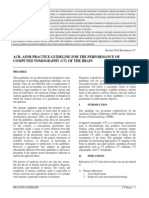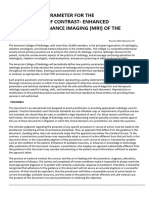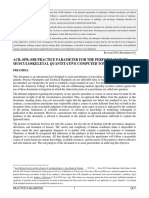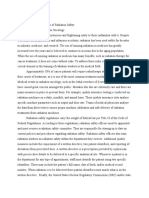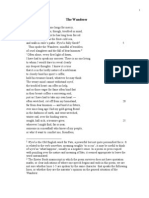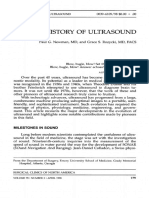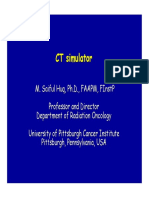HRCT Lungs
HRCT Lungs
Uploaded by
catalyst1986Copyright:
Available Formats
HRCT Lungs
HRCT Lungs
Uploaded by
catalyst1986Original Title
Copyright
Available Formats
Share this document
Did you find this document useful?
Is this content inappropriate?
Copyright:
Available Formats
HRCT Lungs
HRCT Lungs
Uploaded by
catalyst1986Copyright:
Available Formats
The American College of Radiology, with more than 30,000 members, is the principal organization of radiologists, radiation oncologists,
and clinical
medical physicists in the United States. The College is a nonprofit professional society whose primary purposes are to advance the science of radiology,
improve radiologic services to the patient, study the socioeconomic aspects of the practice of radiology, and encourage continuing education for
radiologists, radiation oncologists, medical physicists, and persons practicing in allied professional fields.
The American College of Radiology will periodically define new practice parameters and technical standards for radiologic practice to help advance the
science of radiology and to improve the quality of service to patients throughout the United States. Existing practice parameters and technical standards
will be reviewed for revision or renewal, as appropriate, on their fifth anniversary or sooner, if indicated.
Each practice parameter and technical standard, representing a policy statement by the College, has undergone a thorough consensus process in which it has
been subjected to extensive review and approval. The practice parameters and technical standards recognize that the safe and effective use of diagnostic
and therapeutic radiology requires specific training, skills, and techniques, as described in each document. Reproduction or modification of the published
practice parameter and technical standard by those entities not providing these services is not authorized.
Revised 2015 (Resolution 17)*
ACR–STR PRACTICE PARAMETER FOR THE PERFORMANCE OF HIGH-
RESOLUTION COMPUTED TOMOGRAPHY (HRCT) OF THE LUNGS IN
ADULTS
PREAMBLE
This document is an educational tool designed to assist practitioners in providing appropriate radiologic care for
patients. Practice Parameters and Technical Standards are not inflexible rules or requirements of practice and are
not intended, nor should they be used, to establish a legal standard of care1. For these reasons and those set forth
below, the American College of Radiology and our collaborating medical specialty societies caution against the
use of these documents in litigation in which the clinical decisions of a practitioner are called into question.
The ultimate judgment regarding the propriety of any specific procedure or course of action must be made by the
practitioner in light of all the circumstances presented. Thus, an approach that differs from the guidance in this
document, standing alone, does not necessarily imply that the approach was below the standard of care. To the
contrary, a conscientious practitioner may responsibly adopt a course of action different from that set forth in this
document when, in the reasonable judgment of the practitioner, such course of action is indicated by the condition
of the patient, limitations of available resources, or advances in knowledge or technology subsequent to
publication of this document. However, a practitioner who employs an approach substantially different from the
guidance in this document is advised to document in the patient record information sufficient to explain the
approach taken.
The practice of medicine involves not only the science, but also the art of dealing with the prevention, diagnosis,
alleviation, and treatment of disease. The variety and complexity of human conditions make it impossible to
always reach the most appropriate diagnosis or to predict with certainty a particular response to treatment.
Therefore, it should be recognized that adherence to the guidance in this document will not assure an accurate
diagnosis or a successful outcome. All that should be expected is that the practitioner will follow a reasonable
course of action based on current knowledge, available resources, and the needs of the patient to deliver effective
and safe medical care. The sole purpose of this document is to assist practitioners in achieving this objective.
1 Iowa Medical Society and Iowa Society of Anesthesiologists v. Iowa Board of Nursing, ___ N.W.2d ___ (Iowa 2013) Iowa Supreme Court refuses to find
that the ACR Technical Standard for Management of the Use of Radiation in Fluoroscopic Procedures (Revised 2008) sets a national standard for who may
perform fluoroscopic procedures in light of the standard’s stated purpose that ACR standards are educational tools and not intended to establish a legal
standard of care. See also, Stanley v. McCarver, 63 P.3d 1076 (Ariz. App. 2003) where in a concurring opinion the Court stated that “published standards or
guidelines of specialty medical organizations are useful in determining the duty owed or the standard of care applicable in a given situation” even though
ACR standards themselves do not establish the standard of care.
PRACTICE PARAMETER HRCT Lungs / 1
I. INTRODUCTION
High-resolution computed tomography (HRCT) imaging of the lungs is well-established for diagnosing and
managing many pulmonary diseases [1-7]. Optimal methods of acquisition and interpretation of HRCT images
require knowledge of anatomy and pathophysiology [8], as well as familiarity with the basic physics and
techniques of computed tomography. This parameter outlines the principles for performing high-quality HRCT of
the lungs.
II. DEFINITIONS
HRCT is the use of thin-section CT images (0.625-mm to 1.5-mm slice thickness) with a high spatial frequency
reconstruction algorithm, to detect and characterize diseases that affect the pulmonary parenchyma and small
airways [9]. Following the development and widespread availability of multidetector CT (MDCT) scanners
capable of acquiring near-isotropic data throughout the entire thorax in a single breath-hold, 2 general approaches
are available for acquiring HRCT images [10-14]. The first and more traditional method entails obtaining axial
HRCT images spaced at 10-mm to 20-mm intervals throughout the lungs. The second method uses the ability of
MDCT scanners to provide volumetric single breath-hold datasets allowing spaced, contiguous, and/or
overlapping HRCT images to be reconstructed. With MDCT, the volumetric data enables multiplanar thin-section
HRCT reconstruction, which facilitates evaluation of the distribution of diffuse lung disease [15,16] and the
application of postprocessing techniques such as maximum intensity projection (MIP), minimum intensity
projection (minIP), and software that uses volumetric data for quantification of features in the lungs and airways
[14,17-19].
Optimal performance of HRCT studies requires familiarity with the advantages and disadvantages of each HRCT
method, with the choice between these approaches reflecting available equipment, clinical indication(s), and
radiation dose considerations.
With both methods, image data are routinely acquired at suspended full inspiration with patients in the supine
position. Additional options, useful in many cases, include obtaining inspiratory prone images to differentiate
posterior lung disease from dependent atelectasis and end-expiratory images to evaluate for air trapping [20-23].
III. GOAL
The main objective of HRCT is to detect, characterize, and determine the extent of diseases that involve the lung
parenchyma and airways.
IV. PATIENT INDICATIONS AND CONTRAINDICATIONS
A. Indications
The indications for the use of HRCT of the lungs include, but are not limited to, the following [2,7,8,24-31]:
1. Evaluation of known or clinically suspected diffuse lung disease that is incompletely evaluated on
standard chest CT or chest x-ray or that which is chest x-ray occult
2. Evaluation of suspected small airway disease
3. Quantification of the extent of diffuse lung disease for evaluating effectiveness of treatment
4. Guidance in selection of the most appropriate site for biopsy of diffuse lung disease
B. Contraindications
There are no absolute contraindications to HRCT of the lungs. As with any imaging procedure, the benefits and
risks should be considered prior to thoracic CT performance.
For the pregnant or potentially pregnant patient, see the ACR–SPR Practice Parameter for Imaging Pregnant or
Potentially Pregnant Adolescents and Women with Ionizing Radiation [32].
2 / HRCT Lungs PRACTICE PARAMETER
For imaging of diffuse lung disease in the pediatric patient, please refer to the ACR-ASER-SCBT-MR-SPR
Practice Parameter for the Performance of Pediatric Computed Tomography (CT) [33].
V. QUALIFICATIONS AND RESPONSIBILITIES OF PERSONNEL
See the ACR Practice Parameter for Performing and Interpreting Diagnostic Computed Tomography (CT) [34].
The physician is responsible for reviewing all indications for the examination, specifying the precise technical
factors to be used for the HRCT study, generating a final report, and monitoring and maintaining the quality of
images and interpretation.
The physician should be thoroughly acquainted with the many anatomic and physiologic manifestations of
thoracic disease. Additionally, supervising physicians should have appropriate knowledge of alternative
modalities for imaging of the thorax, including chest radiography and standard thoracic CT, as well as
angiography, ultrasonography, magnetic resonance imaging, and nuclear medicine studies.
The CT technologist must be familiar with optimal techniques for acquiring an HRCT examination, and in the
particular need to communicate breathing instructions with the patient to ensure high-quality, motion-free
inspiratory and expiratory images.
VI. SPECIFICATIONS AND PERFORMANCE OF THE EXAMINATION
A. Written Request for the Examination
The written or electronic request for a HRCT of the lungs should provide sufficient information to demonstrate
the medical necessity of the examination and allow for its proper performance and interpretation.
Documentation that satisfies medical necessity includes 1) signs and symptoms and/or 2) relevant history
(including known diagnoses). Additional information regarding the specific reason for the examination or a
provisional diagnosis would be helpful and may at times be needed to allow for the proper performance and
interpretation of the examination.
The request for the examination must be originated by a physician or other appropriately licensed health care
provider. The accompanying clinical information should be provided by a physician or other appropriately
licensed health care provider familiar with the patient’s clinical problem or question and consistent with the state
scope of practice requirements. (ACR Resolution 35, adopted in 2006)
B. Technical Parameters
Although many of the operations of a CT scanner are automated, a number of technical parameters remain
operator-dependent. As these factors can significantly affect the diagnostic value of the HRCT examination
[4,23,35,36], it is necessary for the supervising physician to be familiar with the following:
1. Radiation exposure factors (mAs, KvP)
2. Collimation
3. Display section thickness for multidetector systems
4. Table increment or pitch and gantry rotation time and table speed
5. Matrix size, scan field of view, and reconstruction field of view
6. Window settings (width and center)
7. Reconstruction algorithm, filter or kernel
8. Image reconstruction interval or increment
PRACTICE PARAMETER HRCT Lungs / 3
9. Detector configuration for multidetector systems
10. Automatic exposure control (angular and longitudinal tube current modulation) and image quality
reference parameter
11. Radiation dose report
12. Reformatted images (multiplanar (MPR), curvilinear, MIP, and minIP) and 3-D surface or volume-
rendered (VR) and image plane (axial, coronal, sagittal)
13. Reconstruction techniques such as filtered back projection or iterative reconstruction
14. Axial or helical mode of the CT scanner
C. Optimal HRCT Protocol
Optimization of the CT examination requires the supervising physician to develop an appropriate HRCT protocol
based on careful review of relevant patient history and clinical indications as well as all prior available imaging
studies that are relevant.
1. Protocols should be prepared according to the specific medical indication. Technique should be selected
that provide image quality consistent with the diagnostic needs of the examination at acceptably low
radiation dose levels to the patient. When volumetric HRCT data are acquired, utilization of the
multiplanar capabilities is encouraged to facilitate assessment of disease distribution and morphology. For
each indication, the protocol should include at least the following:
a. Tube potential and tube current appropriate to patient size. Typically this entails use of 120 (kVp) and
approximately ≤240 mAs. Use of lower tube potentials (eg, 100 kVp) and tube-current settings is
encouraged, especially for younger patients or those who may need serial imaging. In this case, using
similar technical parameters for each study facilitates direct comparison between studies and is of
particular value if quantitative CT measurements are employed.
b. Utilization of techniques available to minimize dose (eg, tube current modulation) is encouraged.
c. Proper supine and/or prone patient positioning with optimal breathing instructions
d. State of respiration (inspiration and/or expiration), with appropriate breathing instructions;
Expiratory images are typically acquired at end-expiration.
e. Table speed for volumetric HRCT to enable single-breath-hold acquisition, when possible
f. Axial (incremental HRCT) or helical (volumetric HRCT) modes of data acquisition. Acquiring
exploratory and/or prone sequence images in a helical fashion is discouraged. For those
sequences, axial acquisition with nonirradiated increments of 10–20 mm or more is preferable.
g. Gantry rotation: ≤1 second
h. Reconstructed image thickness (≤ 1.5 mm for axial CT, ≤1.5 mm nominal slice thickness for helical
CT)
i. Moderately high-spatial-frequency reconstruction algorithm, such as a bone algorithm for lung
images
j. Proper patient positioning (positioning the patient at isocenter to minimize radiation dose and
optimize image quality)
k. Superior and inferior extent of the region of interest to be imaged, typically from the lung apices to
the costophrenic sulci. For additional series such as prone or expiratory HRCT imaging, shorter z-axis
coverage and/or greater increment between imaging locations is encouraged to decrease patient
radiation exposure.
l. When possible, scan field of view should be selected appropriate to patient size at time of image.
m. Reconstructed field of view limited to the lungs adjusted for small, medium, and large patients to
optimize spatial resolution for each patient
n. Plane, thickness, and interval for reconstructions or reformats (eg, coronal, sagittal, oblique MPRs
and MIPs) from volumetric HRCT data to be sent to the picture archiving and communications
system (PACS) or reconstruction directly at the PACS workstation.
o. Retention of the radiation dose report in the radiological record, in alignment with the ACR-SCBT-
MR-SPR Practice Parameter for the Performance of Thoracic Computed Tomography [37].
4 / HRCT Lungs PRACTICE PARAMETER
2. Attention should be directed toward the following:
a. Radiation dose to the degree indicated in the ACR-SCBT-MR-SPR Practice Parameter for the
Performance of Thoracic Computed Tomography [37], considering factors influencing radiation dose,
particularly for small adults. Techniques such as increasing pitch, lowering tube current or kV, and
limiting the z-axis coverage to the region of clinical question. Other factors that can decrease
radiation dose are the use of sequential acquisition and larger interscan gap, which can be employed
when expiratory and prone HRCT imaging is performed to supplement an inspiratory examination.
The necessity of prone imaging should be considered in all patients, particularly on subsequent HRCT
scans; omitting unnecessary sequences provides an opportunity to reduce dose. Alternatives to breast
shielding need to be carefully considered and utilized. Please refer to the AAPM Position Statement
on the Use of Bismuth Shielding for the Purpose of Dose Reduction in CT Scanning at
(http://www.aapm.org/publicgeneral/BismuthShielding.pdf).
b. Producing motion-free images at the appropriate inspiratory and expiratory level
3. Use of intravenous (IV) iodinated contrast should not be used when performing an HRCT to evaluate the
lung parenchyma and small airways primarily, as subtle pulmonary findings may be obscured by
intrapulmonary contrast. In addition, IV contrast adds little value to the interpretation of diffuse lung
disease while exposing patients to the risks associated with the administration of iodinated contrast.
4. Periodic update and review of the HRCT protocol
VII. DOCUMENTATION
Reporting should be in accordance with the ACR Practice Parameter for Communication of Diagnostic Imaging
Findings [38,39].
VIII. EQUIPMENT SPECIFICATIONS
To achieve acceptable clinical HRCT scans of the lungs, a CT scanner should meet or exceed the following
capabilities as specified in the ACR-SCBT-MR-SPR Practice Parameter for the Performance of Thoracic
Computed Tomography [37]:
1. Scan times: ≤1 second per image; A scan time of <1 second per image may apply to direct axial
acquisition but may not apply to helical CT acquisition of HRCT images.
2. Image thickness: ≤ 1.5 mm
3. Algorithm available: bone or moderately high-spatial frequency
4. Axial mode available on CT scanner
Review capability of a PACS workstation should be available to the radiologist; authorized health care providers
should be able to review images remotely. A method for digitally transmitting the image data should be
available.
IX. RADIATION SAFETY IN IMAGING
Radiologists, medical physicists, registered radiologist assistants, radiologic technologists, and all supervising
physicians have a responsibility for safety in the workplace by keeping radiation exposure to staff, and to society
as a whole, “as low as reasonably achievable” (ALARA) and to assure that radiation doses to individual patients
are appropriate, taking into account the possible risk from radiation exposure and the diagnostic image quality
necessary to achieve the clinical objective. All personnel that work with ionizing radiation must understand the
key principles of occupational and public radiation protection (justification, optimization of protection and
application of dose limits) and the principles of proper management of radiation dose to patients (justification,
optimization and the use of dose reference levels) http://www-
pub.iaea.org/MTCD/Publications/PDF/Pub1578_web-57265295.pdf.
PRACTICE PARAMETER HRCT Lungs / 5
Nationally developed guidelines, such as the ACR’s Appropriateness Criteria®, should be used to help choose the
most appropriate imaging procedures to prevent unwarranted radiation exposure.
Facilities should have and adhere to policies and procedures that require varying ionizing radiation examination
protocols (plain radiography, fluoroscopy, interventional radiology, CT) to take into account patient body habitus
(such as patient dimensions, weight, or body mass index) to optimize the relationship between minimal radiation
dose and adequate image quality. Automated dose reduction technologies available on imaging equipment should
be used whenever appropriate. If such technology is not available, appropriate manual techniques should be used.
Additional information regarding patient radiation safety in imaging is available at the Image Gently® for
children (www.imagegently.org) and Image Wisely® for adults (www.imagewisely.org) websites. These
advocacy and awareness campaigns provide free educational materials for all stakeholders involved in imaging
(patients, technologists, referring providers, medical physicists, and radiologists).
Radiation exposures or other dose indices should be measured and patient radiation dose estimated for
representative examinations and types of patients by a Qualified Medical Physicist in accordance with the
applicable ACR technical standards. Regular auditing of patient dose indices should be performed by comparing
the facility’s dose information with national benchmarks, such as the ACR Dose Index Registry, the NCRP
Report No. 172, Reference Levels and Achievable Doses in Medical and Dental Imaging: Recommendations for
the United States or the Conference of Radiation Control Program Director’s National Evaluation of X-ray
Trends. (ACR Resolution 17 adopted in 2006 – revised in 2009, 2013, Resolution 52).
X. QUALITY CONTROL AND IMPROVEMENT, SAFETY, INFECTION
CONTROL AND PATIENT EDUCATION
Policies and procedures related to quality, patient education, infection control, and safety should be developed and
implemented in accordance with the ACR Policy on Quality Control and Improvement, Safety, Infection Control,
and Patient Education appearing under the heading Position Statement on QC & Improvement, Safety, Infection
Control, and Patient Education on the ACR website (http://www.acr.org/guidelines).
Equipment performance monitoring should be in accordance with the ACR–AAPM Technical Standard for
Diagnostic Medical Physics Performance Monitoring of Computed Tomography (CT) Equipment [40].
ACKNOWLEDGEMENTS
This parameter was revised according to the process described under the heading The Process for Developing
ACR Practice Parameters and Technical Standards on the ACR website (http://www.acr.org/guidelines) by the
Committee on Body Imaging (Thoracic) of the Commission on Body Imaging and the Committee on Practice
Parameters – General, Small and Rural Practice of the Commission on General, Small, and Rural Practice, in
collaboration with the STR.
Collaborative Committee
Members represent their societies in the initial and final revision of this practice parameter.
ACR STR
Jane P. Ko, MD, Chair Jonathan H. Chung, MD
Lonnie J. Bargo, MD David Lynch, MB ChB
Lynn S. Broderick, MD, FACR, FCCP Eric J. Stern, MD
Andetta Hunsaker, MD
Committee on Body Imaging (Thoracic)
(ACR Committee responsible for sponsoring the draft through the process)
Ella A. Kazerooni, MD, FACR, Chair
6 / HRCT Lungs PRACTICE PARAMETER
William C. Black, MD
Lynn S. Broderick, MD, FACR, FCCP
Andetta R. Hunsaker, MD
Jane P. Ko, MD
Ann N. Leung, MD
Cristopher A. Meyer, MD, FACR
Reginald F. Munden, MD, DMD, MBA, FACR
Jo-Anne O. Shepard, MD
Shawn D. Teague, MD, FACR
Charles S. White, MD, FACR
Committee on Practice Parameters – General, Small, and Rural Practice
(ACR Committee responsible for sponsoring the draft through the process)
Matthew S. Pollack, MD, FACR, Chair
Sayed Ali, MD
Gory Ballester, MD
Lonnie J. Bargo, MD
Christopher M. Brennan, MD, PhD
Resmi A. Charalel, MD
Candice A. Johnstone, MD
Pil S. Kang, MD
Jason B. Katzen, MD
Serena McClam Liebengood, MD
Gagandeep S. Mangat, MD
Tammam N. Nehme, MD
Lincoln L. Berland, MD, FACR, Chair, Commission on Body Imaging
Lawrence A. Liebscher, MD, FACR, Chair, Commission on GSR
Debra L. Monticciolo, MD, FACR, Chair, Commission on Quality and Safety
Jacqueline Anne Bello, MD, FACR, Vice-Chair, Commission on Quality and Safety
Julie K. Timins, MD, FACR, Chair, Committee on Practice Parameters and Technical Standards
Matthew S. Pollack, MD, FACR, Vice Chair, Committee on Practice Parameters and Technical Standards
Comments Reconciliation Committee
Ezequiel Silva III, MD, Chair
Andrew Moriarity, MD, Co-Chair
Kimberly E. Applegate, MD, MS, FACR
Lonnie J. Bargo, MD
Lincoln L. Berland MD, FACR
Andrew J. Bierhals, MD
Lynn S. Broderick, MD, FACR, FCCP
Jonathan H. Chung, MD
Demetrius L. Dicks, MD
Ralph Drosten, MD, MB, BCh
William T. Herrington, MD, FACR
Andetta Hunsaker, MD
Carlos Jamis-Dow, MD
Ella A. Kazerooni, MD, FACR
Jane P. Ko, MD
Lawrence A. Liebscher, MD, FACR
David Lynch, MD, MB ChB
PRACTICE PARAMETER HRCT Lungs / 7
Cristopher A. Meyer, MD, FACR
Debra L. Monticciolo, MD, FACR
Matthew S. Pollack, MD, FACR
Eric J. Stern, MD
Shawn D. Teague, MD, FACR
Julie K. Timins, MD, FACR
REFERENCES
1. Travis WD, Costabel U, Hansell DM, et al. An official American Thoracic Society/European Respiratory
Society statement: Update of the international multidisciplinary classification of the idiopathic interstitial
pneumonias. Am J Respir Crit Care Med. 2013;188(6):733-748.
2. Brown KK. Chronic cough due to nonbronchiectatic suppurative airway disease (bronchiolitis): ACCP
evidence-based clinical practice guidelines. Chest. 2006;129(1 Suppl):132S-137S.
3. Baughman RP, Meyer KC, Nathanson I, et al. Monitoring of nonsteroidal immunosuppressive drugs in
patients with lung disease and lung transplant recipients: American College of Chest Physicians evidence-
based clinical practice guidelines. Chest. 2012;142(5):e1S-e111S.
4. Webb WR, Muller NL, Naidich DP. High-resolution CT of the Lung. Fourth ed. Philadelphia, PA: Lippincott
Williams & Wilkins; 2008.
5. Devakonda A, Raoof S, Sung A, Travis WD, Naidich D. Bronchiolar disorders: a clinical-radiological
diagnostic algorithm. Chest. 2010;137(4):938-951.
6. Watadani T, Sakai F, Johkoh T, et al. Interobserver variability in the CT assessment of honeycombing in the
lungs. Radiology. 2013;266(3):936-944.
7. Lynch DA, Travis WD, Muller NL, et al. Idiopathic interstitial pneumonias: CT features. Radiology.
2005;236(1):10-21.
8. Webb WR. Thin-section CT of the secondary pulmonary lobule: anatomy and the image--the 2004 Fleischner
lecture. Radiology. 2006;239(2):322-338.
9. Kazerooni EA. High-resolution CT of the lungs. AJR Am J Roentgenol. 2001;177(3):501-519.
10. Hodnett PA, Naidich DP. Fibrosing interstitial lung disease. A practical high-resolution computed
tomography-based approach to diagnosis and management and a review of the literature. Am J Respir Crit
Care Med. 2013;188(2):141-149.
11. Honda O, Takenaka D, Matsuki M, et al. Image quality of 320-detector row wide-volume computed
tomography with diffuse lung diseases: comparison with 64-detector row helical CT. J Comput Assist
Tomogr. 2012;36(5):505-511.
12. Schoepf UJ, Bruening RD, Hong C, et al. Multislice helical CT of focal and diffuse lung disease:
comprehensive diagnosis with reconstruction of contiguous and high-resolution CT sections from a single
thin-collimation scan. AJR Am J Roentgenol. 2001;177(1):179-184.
13. Studler U, Gluecker T, Bongartz G, Roth J, Steinbrich W. Image quality from high-resolution CT of the lung:
comparison of axial scans and of sections reconstructed from volumetric data acquired using MDCT. AJR Am
J Roentgenol. 2005;185(3):602-607.
14. Prosch H, Schaefer-Prokop CM, Eisenhuber E, Kienzl D, Herold CJ. CT protocols in interstitial lung
diseases--a survey among members of the European Society of Thoracic Imaging and a review of the
literature. Eur Radiol. 2013;23(6):1553-1563.
15. Remy-Jardin M, Campistron P, Amara A, et al. Usefulness of coronal reformations in the diagnostic
evaluation of infiltrative lung disease. J Comput Assist Tomogr. 2003;27(2):266-273.
16. Johkoh T, Muller NL, Nakamura H. Multidetector spiral high-resolution computed tomography of the lungs:
distribution of findings on coronal image reconstructions. J Thorac Imaging. 2002;17(4):291-305.
17. Beigelman-Aubry C, Hill C, Guibal A, Savatovsky J, Grenier PA. Multi-detector row CT and postprocessing
techniques in the assessment of diffuse lung disease. Radiographics. 2005;25(6):1639-1652.
18. Rossi A, Attina D, Borgonovi A, et al. Evaluation of mosaic pattern areas in HRCT with Min-IP
reconstructions in patients with pulmonary hypertension: could this evaluation replace lung perfusion
scintigraphy? Eur J Radiol. 2012;81(1):e1-6.
19. Satoh S, Kitazume Y, Taura S, Kimula Y, Shirai T, Ohdama S. Pulmonary emphysema: histopathologic
correlation with minimum intensity projection imaging, high-resolution computed tomography, and
pulmonary function test results. J Comput Assist Tomogr. 2008;32(4):576-582.
8 / HRCT Lungs PRACTICE PARAMETER
20. Arakawa H, Webb WR. Expiratory high-resolution CT scan. Radiol Clin North Am. 1998;36(1):189-209.
21. Gunn ML, Godwin JD, Kanne JP, Flowers ME, Chien JW. High-resolution CT findings of bronchiolitis
obliterans syndrome after hematopoietic stem cell transplantation. J Thorac Imaging. 2008;23(4):244-250.
22. Kashiwabara K, Kohshi S. Additional computed tomography scans in the prone position to distinguish early
interstitial lung disease from dependent density on helical computed tomography screening patient
characteristics. Respirology. 2006;11(4):482-487.
23. Mayo JR. CT evaluation of diffuse infiltrative lung disease: dose considerations and optimal technique. J
Thorac Imaging. 2009;24(4):252-259.
24. Padley S, Gleeson F, Flower CD. Review article: current indications for high resolution computed
tomography scanning of the lungs. Br J Radiol. 1995;68(806):105-109.
25. Hackx M, Bankier AA, Gevenois PA. Chronic obstructive pulmonary disease: CT quantification of airways
disease. Radiology. 2012;265(1):34-48.
26. Litmanovich DE, Hartwick K, Silva M, Bankier AA. Multidetector computed tomographic imaging in
chronic obstructive pulmonary disease: emphysema and airways assessment. Radiol Clin North Am.
2014;52(1):137-154.
27. Silva CI, Muller NL, Lynch DA, et al. Chronic hypersensitivity pneumonitis: differentiation from idiopathic
pulmonary fibrosis and nonspecific interstitial pneumonia by using thin-section CT. Radiology.
2008;246(1):288-297.
28. Silva CI, Churg A, Muller NL. Hypersensitivity pneumonitis: spectrum of high-resolution CT and pathologic
findings. AJR Am J Roentgenol. 2007;188(2):334-344.
29. Saavedra MT, Lynch DA. Emerging roles for CT imaging in cystic fibrosis. Radiology. 2009;252(2):327-329.
30. Walsh SL, Hansell DM. High-Resolution CT of Interstitial Lung Disease: A Continuous Evolution. Semin
Respir Crit Care Med. 2014;35(1):129-144.
31. Gotway MB, Reddy GP, Webb WR, Elicker BM, Leung JW. High-resolution CT of the lung: patterns of
disease and differential diagnoses. Radiol Clin North Am. 2005;43(3):513-542, viii.
32. American College of Radiology. ACR–SPR Practice Parameter for Imaging Pregnant or Potentially Pregnant
Adolescents and Women with Ionizing Radiation. 2014; https://www.acr.org/-/media/ACR/Files/Practice-
Parameters/Pregnant-Pts.pdf. Accessed October 6, 2014.
33. American College of Radiology. ACR-ASER-SCBT-MR-SPR Practice Parameter for the Performance of
Pediatric Computed Tomography (CT). 2014; https://www.acr.org/-/media/ACR/Files/Practice-
Parameters/CT-Ped.pdf. Accessed October 6, 2014.
34. American College of Radiology. ACR Practice Parameter for Performing and Interpreting Diagnostic
Computed Tomography (CT). 2014; https://www.acr.org/-/media/ACR/Files/Practice-Parameters/CT-Perf-
Interpret.pdf. Accessed October 6, 2014.
35. Bankier AA, Fleischmann D, Mallek R, et al. Bronchial wall thickness: appropriate window settings for thin-
section CT and radiologic-anatomic correlation. Radiology. 1996;199(3):831-836.
36. Christe A, Charimo-Torrente J, Roychoudhury K, Vock P, Roos JE. Accuracy of low-dose computed
tomography (CT) for detecting and characterizing the most common CT-patterns of pulmonary disease. Eur J
Radiol. 2013;82(3):e142-150.
37. American College of Radiology. ACR-SCBT-MR-SPR Practice Parameter for the Performance of Thoracic
Computed Tomography. 2014; https://www.acr.org/-/media/ACR/Files/Practice-Parameters/CT-Thoracic.pdf.
Accessed October 6, 2014.
38. American College of Radiology. ACR Practice Parameter for Communication of Diagnostic Imaging
Findings. 2014; https://www.acr.org/-/media/ACR/Files/Practice-Parameters/CommunicationDiag.pdf,
October 6.
39. Hansell DM, Bankier AA, MacMahon H, McLoud TC, Muller NL, Remy J. Fleischner Society: glossary of
terms for thoracic imaging. Radiology. 2008;246(3):697-722.
40. American College of Radiology. ACR–AAPM Technical Standard for Diagnostic Medical Physics
Performance Monitoring of Computed Tomography (CT) Equipment. 2014; https://www.acr.org/-
/media/ACR/Files/Practice-Parameters/CT-Equip.pdf. Accessed October 6, 2014.
PRACTICE PARAMETER HRCT Lungs / 9
*Practice parameters and technical standards are published annually with an effective date of October 1 in the
year in which amended, revised, or approved by the ACR Council. For practice parameters and technical
standards published before 1999, the effective date was January 1 following the year in which the practice
parameter or technical standard was amended, revised, or approved by the ACR Council.
Development Chronology for this Practice Parameter
2000 (Resolution 10)
Revised 2005 (Resolution 28)
Amended 2006 (Resolution 17, 35)
Revised 2010 (Resolution 43)
Amended 2014 (Resolution 39)
Revised 2015 (Resolution 17)
10 / HRCT Lungs PRACTICE PARAMETER
You might also like
- Libro R. Khandpur-Biomedical Instrumentation - Technology and Applications-McGraw-Hill Professional (2004)Document943 pagesLibro R. Khandpur-Biomedical Instrumentation - Technology and Applications-McGraw-Hill Professional (2004)Dulcina Tucuman100% (18)
- Acr Practice Parameter For Breast UltrasoundDocument7 pagesAcr Practice Parameter For Breast UltrasoundBereanNo ratings yet
- Aapm TG 66Document31 pagesAapm TG 66Anjiharts100% (3)
- Hospital Support Services PDFDocument244 pagesHospital Support Services PDFsudipta4321100% (8)
- Acr Practice Parameter For Diagnostic CTDocument9 pagesAcr Practice Parameter For Diagnostic CTBereanNo ratings yet
- ACR Recomendations On Exposure TimeDocument9 pagesACR Recomendations On Exposure TimeMuhammad AreebNo ratings yet
- Breast USDocument8 pagesBreast USCucuteanu DanNo ratings yet
- Acr - SPR - Sru Practice Parameter For The Performing andDocument6 pagesAcr - SPR - Sru Practice Parameter For The Performing andModou NianeNo ratings yet
- Fluoroscopic EquipmentDocument9 pagesFluoroscopic Equipmentklearoseni31No ratings yet
- Myelography PDFDocument13 pagesMyelography PDFAhmad HaririNo ratings yet
- Acr-Spr Practice Parameter For The Use of Intravascular Contrast MediaDocument8 pagesAcr-Spr Practice Parameter For The Use of Intravascular Contrast MediaSergio MoradelNo ratings yet
- Acr Practice Parameter For The Performance of HysterosalpingographyDocument9 pagesAcr Practice Parameter For The Performance of HysterosalpingographyAsif JielaniNo ratings yet
- Acr Practice Parameter For MriDocument9 pagesAcr Practice Parameter For MriBereanNo ratings yet
- IMRT - ACR - ASTRO GuidelinesDocument11 pagesIMRT - ACR - ASTRO GuidelinesSayan DasNo ratings yet
- Reference Levels Diagnostic XrayDocument9 pagesReference Levels Diagnostic XrayDavide ModenaNo ratings yet
- US ExtracranialCerebroDocument9 pagesUS ExtracranialCerebroMilica OstojicNo ratings yet
- US EquipmentDocument8 pagesUS Equipmentklearoseni31No ratings yet
- USPeriph ArterialDocument11 pagesUSPeriph ArterialMilica OstojicNo ratings yet
- Acr-Nasci-Sir-Spr Practice Parameter For The Performance and Interpretation of Body Computed Tomography Angiography (Cta)Document15 pagesAcr-Nasci-Sir-Spr Practice Parameter For The Performance and Interpretation of Body Computed Tomography Angiography (Cta)kirim mammoNo ratings yet
- US PeriphVenousDocument11 pagesUS PeriphVenousMilica OstojicNo ratings yet
- Acr Technical Standard For Diagnostic Medical Physics Performance Monitoring of Magnetic Resonance Imaging (Mri) EquipmentDocument4 pagesAcr Technical Standard For Diagnostic Medical Physics Performance Monitoring of Magnetic Resonance Imaging (Mri) EquipmentFarkhan Putra IINo ratings yet
- Responsibility of MPDocument13 pagesResponsibility of MPEskadmas BelayNo ratings yet
- Acr Technical Standard For Diagnostic Procedures Using RadiopharmaceuticalsDocument7 pagesAcr Technical Standard For Diagnostic Procedures Using Radiopharmaceuticalstarginosantos100% (1)
- Acr-Astro Practice Guideline For Image-Guided Radiation Therapy (Igrt)Document9 pagesAcr-Astro Practice Guideline For Image-Guided Radiation Therapy (Igrt)freemind_mxNo ratings yet
- Acr-Spr Practice Parameter For The Performance and Interpretation of Skeletal Surveys in ChildrenDocument9 pagesAcr-Spr Practice Parameter For The Performance and Interpretation of Skeletal Surveys in ChildrenPediatría grupoNo ratings yet
- Acr Practice Parameter For The Performance of Fluoroscopic Contrast Enema Examination in AdultsDocument8 pagesAcr Practice Parameter For The Performance of Fluoroscopic Contrast Enema Examination in AdultsHercules RianiNo ratings yet
- Acr Practice Parameter For Digital Breast Tomosynthesis DBTDocument7 pagesAcr Practice Parameter For Digital Breast Tomosynthesis DBTBereanNo ratings yet
- Acr-Spr-Ssr Practice Parameter For The Performance of Radiography of The ExtremitiesDocument8 pagesAcr-Spr-Ssr Practice Parameter For The Performance of Radiography of The ExtremitiesEdiPtkNo ratings yet
- CT Brain GuidelinesDocument6 pagesCT Brain GuidelinesMurali G RaoNo ratings yet
- Acr-Asnr-Assr-Spr Practice Parameter For The Performance of Computed Tomography (CT) of The SpineDocument17 pagesAcr-Asnr-Assr-Spr Practice Parameter For The Performance of Computed Tomography (CT) of The SpineHernan VillafañeNo ratings yet
- Guia ACR Resonancia FuncionalDocument7 pagesGuia ACR Resonancia Funcionalseb2008No ratings yet
- Us ObDocument16 pagesUs ObWahyu RianiNo ratings yet
- Diag Ref LevelsDocument20 pagesDiag Ref Levelsvefijo4087No ratings yet
- SNMMI Procedure Standard-EANM Practice Guideline For SSTR PET - Imaging Neuroendocrine TumorsDocument7 pagesSNMMI Procedure Standard-EANM Practice Guideline For SSTR PET - Imaging Neuroendocrine TumorsdynachNo ratings yet
- US PelvisDocument11 pagesUS PelvisDian Putri NingsihNo ratings yet
- Acr Practice Parameter For Contrast Mri BreastDocument11 pagesAcr Practice Parameter For Contrast Mri BreastBereanNo ratings yet
- MR Contrast BreastDocument11 pagesMR Contrast Breastchenqping275595110No ratings yet
- MRJLLDocument18 pagesMRJLLNutchaiSaengsurathamNo ratings yet
- Acr-Spr-Ssr Practice Parameter For The Performance of Dual-Energy X-Ray Absorptiometry (Dxa)Document15 pagesAcr-Spr-Ssr Practice Parameter For The Performance of Dual-Energy X-Ray Absorptiometry (Dxa)Pablo PinedaNo ratings yet
- Neurosonog ACR Neonates 2019Document8 pagesNeurosonog ACR Neonates 2019Modou NianeNo ratings yet
- ScoliosisDocument10 pagesScoliosisSilma FarrahaNo ratings yet
- MR AbdDocument14 pagesMR AbdKhairunNisaNo ratings yet
- Acr-Spr-Ssr Practice Parameter For The Performance of Musculoskeletal Quantitative Computed Tomography (QCT)Document14 pagesAcr-Spr-Ssr Practice Parameter For The Performance of Musculoskeletal Quantitative Computed Tomography (QCT)Rahmanu ReztaputraNo ratings yet
- Advice On The Legislation For The Use of Radiation Equipment in The Dental PracticeDocument8 pagesAdvice On The Legislation For The Use of Radiation Equipment in The Dental Practiceiqbal.ha9646No ratings yet
- Acr-Ars Practice Parameter For The Performance of Total Body IrradiationDocument12 pagesAcr-Ars Practice Parameter For The Performance of Total Body IrradiationJuan Pablo MazueraNo ratings yet
- Screen Diag MammoDocument14 pagesScreen Diag MammoCucuteanu DanNo ratings yet
- RCT - Scope - of - Practice - Diagnostic - Rad - 22 - May - 2020 - For Current - ScopeDocument5 pagesRCT - Scope - of - Practice - Diagnostic - Rad - 22 - May - 2020 - For Current - ScopeNolizwi NkosiNo ratings yet
- Informed Consent Image Guide PDFDocument6 pagesInformed Consent Image Guide PDFRavish MalhotraNo ratings yet
- International EANM SNMMI ISMRM Consensus Recommendation For PET/MRI in OncologyDocument25 pagesInternational EANM SNMMI ISMRM Consensus Recommendation For PET/MRI in OncologyIonuț RusNo ratings yet
- Digital RadiographyDocument34 pagesDigital RadiographyHarbi Al-JaabaryNo ratings yet
- Esophagrams Upper GIDocument11 pagesEsophagrams Upper GIMark M. AlipioNo ratings yet
- AAOMR Cone Beam PaperDocument2 pagesAAOMR Cone Beam PaperJing XueNo ratings yet
- EANM Guidelines For PET-CT and PET-MR Routine Quality 2022-23Document11 pagesEANM Guidelines For PET-CT and PET-MR Routine Quality 2022-23p110054No ratings yet
- Standard Operating Procedure For X-Ray ExaminationsDocument23 pagesStandard Operating Procedure For X-Ray ExaminationsArslan zNo ratings yet
- Capstone IVDocument10 pagesCapstone IVapi-631736561No ratings yet
- MRI WristDocument14 pagesMRI WristFarkhan Putra IINo ratings yet
- Medical Physicist Staffing For Nuclear Medicine and Dose-Intensive X-Ray ProceduresDocument14 pagesMedical Physicist Staffing For Nuclear Medicine and Dose-Intensive X-Ray ProceduresNasir IqbalNo ratings yet
- Radiation Safety-Nicolette SawickiDocument4 pagesRadiation Safety-Nicolette Sawickiapi-484758207No ratings yet
- Radiation Safety PaperDocument3 pagesRadiation Safety Paperapi-635186395No ratings yet
- Radiation SafetyDocument4 pagesRadiation Safetybraith7811No ratings yet
- Thrall 2014Document5 pagesThrall 2014Rudi IlhamsyahNo ratings yet
- AFFIDAVIT PCPNDTDocument1 pageAFFIDAVIT PCPNDTcatalyst1986100% (1)
- Application - Format CILDocument3 pagesApplication - Format CILcatalyst1986No ratings yet
- AFFIDAVIT PCPNDTDocument1 pageAFFIDAVIT PCPNDTcatalyst1986100% (1)
- RNTCP PresentationDocument65 pagesRNTCP Presentationcatalyst1986100% (1)
- Maharashtra Govt. RehabDocument2 pagesMaharashtra Govt. Rehabcatalyst1986No ratings yet
- The Scheduled Castes and Scheduled Tribes (Prevention of Atrocities) Act, 1989Document6 pagesThe Scheduled Castes and Scheduled Tribes (Prevention of Atrocities) Act, 1989catalyst1986No ratings yet
- WandererDocument4 pagesWanderercatalyst1986No ratings yet
- Font Expert 2010Document67 pagesFont Expert 2010Sergey KuzmichNo ratings yet
- Konsep Dasar, Optimalisasi, Dan Teknik Pengurangan Dosis Pada Pesawat CT ScanDocument31 pagesKonsep Dasar, Optimalisasi, Dan Teknik Pengurangan Dosis Pada Pesawat CT Scanrifqi anisaNo ratings yet
- Q4 Health 10 Module 3Document20 pagesQ4 Health 10 Module 3anthonneac100% (1)
- IEEE PAPER BATCH NO-03 A NOVEL OBJECT DETECTION MODEL (YOLOv5) FOR IMPROVED LUNG NODULE IDENTIFICATION IN MEDICAL IMAGESDocument7 pagesIEEE PAPER BATCH NO-03 A NOVEL OBJECT DETECTION MODEL (YOLOv5) FOR IMPROVED LUNG NODULE IDENTIFICATION IN MEDICAL IMAGESS.GOPINATH5035No ratings yet
- What Is Medical Equipment and Types of Medical EquipmentDocument5 pagesWhat Is Medical Equipment and Types of Medical EquipmentNor Hassan AmbaNo ratings yet
- Newman 1998Document17 pagesNewman 1998Alex OsunaNo ratings yet
- Septic Arthritis and Prosthetic Joint Infection in Older AdultsDocument15 pagesSeptic Arthritis and Prosthetic Joint Infection in Older AdultsajengmdNo ratings yet
- Tim Wintz and Jarett Greenside Promoted To Senior Vice Presidents of Radiology For NY Imaging SpecialistsDocument3 pagesTim Wintz and Jarett Greenside Promoted To Senior Vice Presidents of Radiology For NY Imaging SpecialistsPR.comNo ratings yet
- WJR 8 656Document13 pagesWJR 8 656aldosaputraNo ratings yet
- Vivid T8Document4 pagesVivid T8muhammed kaletNo ratings yet
- Huq CT SimulatorDocument65 pagesHuq CT SimulatorEskadmas BelayNo ratings yet
- Information Resources For Nuclear MedicineDocument7 pagesInformation Resources For Nuclear MedicineBora NrttrkNo ratings yet
- Siemens Prima PDFDocument7 pagesSiemens Prima PDFramon navaNo ratings yet
- Admas University School of Post Graduate Masters of Business AdministrationDocument16 pagesAdmas University School of Post Graduate Masters of Business AdministrationAbnet BeleteNo ratings yet
- Visage7 Client OnlineHelp EN V15Document206 pagesVisage7 Client OnlineHelp EN V15roba97.rmNo ratings yet
- FInal Assessment Techniques in Neuropsychology (1) - 1Document34 pagesFInal Assessment Techniques in Neuropsychology (1) - 1mishal.sarosh75No ratings yet
- Pressure Injectors For Radiologists A Review and WDocument10 pagesPressure Injectors For Radiologists A Review and WL. K. Das100% (1)
- Acute Groin Injuries: Experiences From AspetarDocument7 pagesAcute Groin Injuries: Experiences From AspetarAbdul Wahid ShaikhNo ratings yet
- Image Annotation For Computer Vision GuideDocument27 pagesImage Annotation For Computer Vision GuideLewsijght GNo ratings yet
- Documentation of Medical Decision MakingDocument11 pagesDocumentation of Medical Decision Makingadultmedicalconsultants100% (7)
- Initial Management of Trauma in Adults - UpToDateDocument37 pagesInitial Management of Trauma in Adults - UpToDateAlberto Kenyo Riofrio PalaciosNo ratings yet
- Inception Cards 906 PDFDocument906 pagesInception Cards 906 PDFgkNo ratings yet
- Foot and Ankle Questions On The OrthopaedicDocument9 pagesFoot and Ankle Questions On The OrthopaedicichkhuyNo ratings yet
- Information For Physiotherapists Thinking About Coming To Work in Ireland Updated Nov 2023 File 2213Document11 pagesInformation For Physiotherapists Thinking About Coming To Work in Ireland Updated Nov 2023 File 2213Irfan khanNo ratings yet
- Printed in Japan 2016-10-3K - (D) : Innova NG Healthcare, Embracing The Future TiDocument8 pagesPrinted in Japan 2016-10-3K - (D) : Innova NG Healthcare, Embracing The Future TiGurunath Gawde100% (1)
- CT KubDocument2 pagesCT KubKumail KhandwalaNo ratings yet
- 6 - Neurodiagnostics II - Essentials of Neuroradiology LectureDocument44 pages6 - Neurodiagnostics II - Essentials of Neuroradiology LectureShailendra Pratap SinghNo ratings yet
- X-Ray Tube Arcing: Manifestation and Detection During Qualuty CONTROL (Journal Medical Physics International, 2018, v.6, P 157-162)Document6 pagesX-Ray Tube Arcing: Manifestation and Detection During Qualuty CONTROL (Journal Medical Physics International, 2018, v.6, P 157-162)Phan Hoàng NamNo ratings yet
- Biophysical TechniquesDocument12 pagesBiophysical TechniquesKaren Joy Reas100% (1)




























